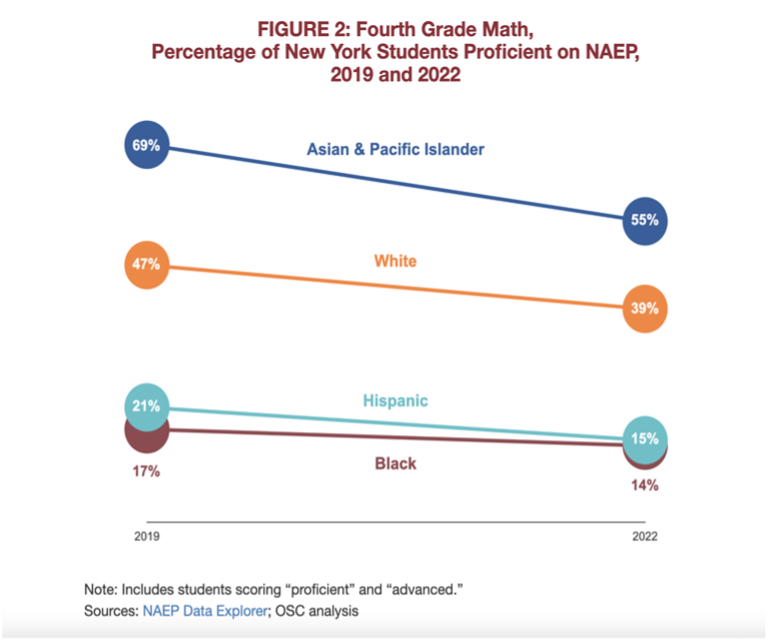
SUMMARY
Along with students across the rest of the country, New York’s students have experienced unprecedented learning loss due to the pandemic. Although high-impact tutoring (HIT) is the most effective intervention in learning recovery, funding opportunities remain contested and scant. While Governor Hochul included $250 million in her budget for HIT, both the Assembly and the State Senate one-house budgets eliminated the HIT proposal because that allocation came from Foundation Aid dollars instead of providing it as a separate budgetary allotment.
If New York’s legislative bodies oppose the use of Foundation Aid for HIT, it is absolutely essential they identify creative funding opportunities elsewhere to support these highly effective recovery programs. Eliminating the budget proposal and not creating a HIT designated fund means failing to provide students with the support they need to excel in the classroom.
This memo provides context for the urgent need for investment in HIT, as well as recommendations for how New York should proceed, including:
- Expand existing learning loss infrastructure, such as the federal NYGear Up program
- Create an additional grant program to support the implementation and expansion of HIT programs throughout New York
- Encourage the immediate use of federal covid relief funds to develop and grow HIT programs
- Tie funding eligibility to fidelity with evidence-based guardrails, such as: consistent and high-quality tutors, data-driven decision making, scheduling during normal school hours, and grade-level curriculums aligned with state standards
- Support programming with quality and well-trained personnel – including tutors, program coordinators, and/or consultants.
INTRODUCTION
The 2022 Nation’s Report Card (National Assessment of Educational Progress[i]) revealed that basic proficiency levels in New York dropped by 10 percentage points in math and 8 percentage points in reading–a larger drop than the national average as noted by New York State Comptroller Tom DiNapoli. In New York, results were lower among historically marginalized communities with proficiency rates of 14% and 15%, respectively, for Black and Hispanic students as compared to 55% for White students. Data shows that opportunity gaps continue to impact Black and Latino/Hispanic students across the state–a reality that dates back long before the pandemic.

In a time of unprecedented drops in academic achievement, we need an urgent and unwavering commitment to effective learning acceleration programs. While an array of strategies is needed, according to a meta-analysis analyzing 14 different educational interventions, high impact tutoring (HIT) is the most effective tool in our toolbox, with the potential to recover over 200 days of learning.
The reality is that many affluent parents were able to hire tutors or learning specialists to help their students navigate the difficulties of the pandemic and withstand the worst of its impacts on learning. However, low-income families rarely had access to these individualized learning opportunities, and providing free and accessible HIT opportunities in our public schools is essential in helping all children recover from disrupted learning.
What distinguishes HIT from less effective tutoring services are the following evidence-based guardrails:
- Occurs during the school day;
- Includes a minimum of three sessions per week for the duration of the school year;
- Occurs in groups of four or fewer students;
- Provides students with a consistent tutor;
- Provides tutors with pre-service training, oversight, ongoing coaching, and clear lines of accountability;
- Uses data to inform tutoring sessions; and
- Uses grade-level materials that are aligned with research and state standards.
Despite overwhelming evidence that HIT is the most effective strategy for combating learning loss, only about 1 in 10 students have access to it. New York must be a leader in expanding these critical learning acceleration opportunities – which can ultimately mean the difference between students recovering from interrupted learning or falling further behind.
RECOMMENDATIONS
Several states have acknowledged HIT’s effectiveness and worked to expand programs throughout their districts. In fact, 32 states including DC have passed initiatives or legislation to incentivize or require districts to offer tutoring opportunities. Governor Kathy Hochul included HIT in her 2023 Executive Budget, allocating $250 million in Foundation Aid, and further collaboration with an external provider to implement the initiative statewide. In order for HIT to be effective as a proposed budgetary item, it needs to be introduced as a singular funding allocation where it receives a pool of designated funds – instead of an addition to an existing aid program.
Experts claim that students may not recover from learning loss by 2028, and that’s only if they continue at the current pace of recovery. By 2028, many students will have graduated, and others may be in high school still struggling with foundational reading skills. This cannot wait. Widespread implementation must be incentivized now and supported at any cost.
We propose the following recommendations to continue to support New York’s most vulnerable students through evidence-based strategies:
- Expand existing infrastructure to address learning loss: There needs to be a stronger consideration and push for expanding NYGear Up[i], an established federal program that has only been awarded $28 million across seven-years. GearUp is a college prep program that only provides services to students beginning in 7th grade, despite the evidence suggesting that tutoring programs are most effective as an early intervention for younger students.
- Create an additional grant program sufficient to meet the needs of New York’s most vulnerable students:The District of Columbia and Colorado are two prime examples of how HIT grant programs can thrive in practice. DC Mayor Muriel Bowser has allocated over $39 million to both schools and external partners with the goal of delivering HIT to at least 10,000 students across the city. Similarly, Colorado elected officials passed the ‘Colorado High-Impact’ Grant Program in 2021, which prioritized underserved students with low-income families and students in rural areas.
- Leverage federal funds: Despite unprecedented federal investments in education through the Elementary and Secondary School Emergency Relief Fund,[ii] much of this funding has yet to be spent. As of January 31, 2023, over $8.3 billion of the $14 billion awarded to New York through ESSER has not yet been spent. Districts must be pushed to use their ESSER funds by 2024 to invest in evidence-based recovery strategies like HIT.
While funding is essential in the implementation and expansion of HIT, it must be accompanied by evidence-based guardrails, state- and district-level support, and designated personnel. We propose the following recommendations:
- Tie funding eligibility to fidelity with evidence-based guardrails: New York’s current budget proposal includes few regulations for HIT implementation, and those that exist are vague or even conflict with existing research. For example:
- The current budget allows HIT to be offered twice per week outside normal school hours, whereas evidence suggests that effective programs occur during the school day at least three times per week.
- The existing budget also fails to mention several other key aspects of HIT, such as: consistent and high-quality tutors, data-driven decision-making, and grade-level curriculums aligned with state standards.
Instead, New York should look to Colorado’s legislation as a gold standard for requiring schools to follow best practices and appeal for individual consideration when this isn’t possible.
- Eliminate unnecessary restrictions for tutor recruitment: Tutor recruitment remains one of the most challenging aspects of HIT implementation and should not be needlessly inhibited by licensing requirements. Requiring tutors to have substitute or teaching licenses is inconsistent with the evidence and with the experiences of administrators across the country who have seen great success upon the recruitment of a less restrictive pool of tutors. Instead, districts should be incentivized to partner with universities and non-profits to recruit and train effective tutors from a variety of backgrounds. Like the District of Columbia, New York should partner with external providers–such as community-based organizations and universities–to recruit personnel as some school districts may be at capacity. New York’s current proposal does not address tutor qualifications or external recruitment efforts.
- Support programming with personnel: While funding is essential in bringing HIT programs to fruition, many schools cannot implement such a complex and ideally wide-reaching program without designated personnel running it. Schools need support in the recruitment and onboarding of program coordinators or even short-term consultants to navigate the initial difficulties of program implementation. It is particularly important that additional personnel be directed towards low-performing schools, who may not have the capacity to actually use their funding to develop new programs.
- Require schools to use data to set goals, monitor progress, and guide decision-making: Data is perhaps one of the most important aspects of HIT, and it must be woven into all aspects of program implementation. Schools must be required to use data to set specific enrollment and outcomes goals; identify students for intervention; inform instructional groups and content; monitor student- and grade- level progress, and make program adjustments when necessary.
Signed on behalf of:
Black, Latinx, and Asian Charter Collaborative
The Business Council of New York State
Education Reform Now New York
The Education Trust New York
Hispanic Federation
Ibero American Action League
National Parents Union – New York
New York Charter Schools Association
Rochester Education Fellowship
Students First New York
We the Parents of WNY
————————————————
Download a PDF version of the memo here.
[i] The National Assessment of Educational Progress (NAEP), which is administered by the U.S. Department of Education’s National Center for Education Statistics (NCES), is the largest nationally representative assessment of student academic performance.
[ii] A competitive grant administered in 2022 by the U.S. Department of Education to increase college readiness and success for more than 6,200 low-income New York State students.
[iii] The Elementary and Secondary School Education Relief (ESSER) Fund was created to help schools recover from the impact of the coronavirus pandemic. ESSER I was passed in March 2020 as part of the CARES Act to facilitate the sudden shift to distance learning in an initial response to Covid-19. ESSER II was passed in December 2020 as part of the CRRSA Act, allocating an additional $54.3 billion to schools. Finally, ESSER III contributed to the single largest pot of federal dollars ever directed to schools, allocating an additional $122 billion under ARP in March 2021.